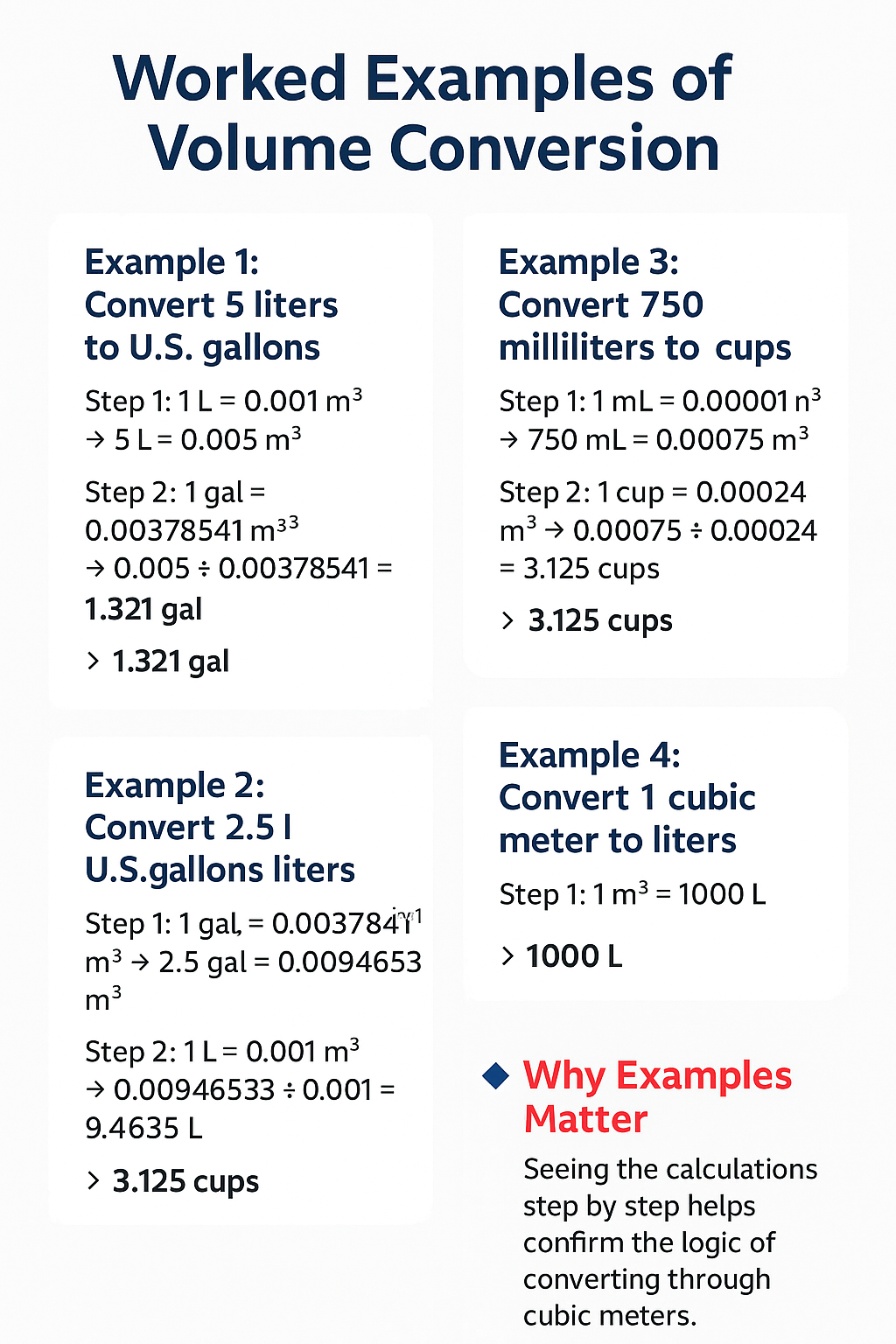Volume Conversion Calculator
Inputs
Result
| Unit | Symbol | Value |
|---|
Embed this calculator
Adjust the size if needed, then copy the code below into your page or blog. The calculator will load in an iframe and stay updated automatically.
✅ Works on most website builders (WordPress, Elementor, HTML, etc.) · Please keep the credit link to support future free tools.
🔹 How to Use the Volume Conversion Calculator
Convert between metric and U.S. customary volume units in seconds. The dropdowns include all supported units: m³, km³, cm³, mm³, L, mL, US gal, US qt, US pt, US cup, US fl oz.
- Enter a value in the Value field (commas and spaces are fine; the parser cleans input).
- Select the source unit in From Unit (e.g., L).
- Select the target unit in To Unit (e.g., US gal).
- Press Convert or simply type—results update live. Use Swap to flip units instantly.
🔹 Reference Factors
| From | To | Factor |
|---|---|---|
| Liter (L) | Milliliter (mL) | × 1,000 |
| US Gallon (gal) | Liter (L) | × 3.78541 |
| US Quart (qt) | Liter (L) | × 0.946353 |
| US Pint (pt) | Liter (L) | × 0.473176 |
| US Cup (cup) | US fl oz | × 8 |
| Cubic Meter (m³) | Liter (L) | × 1,000 |
| Cubic Centimeter (cm³) | Milliliter (mL) | 1:1 |
🔹 Tips & Use Cases
- Cooking & beverages: Convert recipes between mL/L and U.S. cups, pints, and ounces.
- Logistics: Convert container sizes (L ↔ m³) for shipping and storage planning.
- Science & labs: Switch between cm³/mL for precise measurements.
Need surface measurements too? Try our Area Conversion Calculator.
🔹 What is Volume Conversion?
Volume conversion is the process of translating one unit of capacity into another. It allows you to compare and calculate the size of liquids, gases, or three-dimensional spaces expressed in different systems such as metric (m³, L, mL) or U.S. customary (gallon, quart, pint, cup, fl oz).
Since the world uses different unit systems, conversion ensures clarity in trade, cooking, science, and shipping. This calculator uses precise factors to guarantee accuracy across all supported units.
🔹 Common Units of Volume
- Metric: cubic meter (m³), liter (L), milliliter (mL), cm³, mm³
- Imperial/U.S. Customary: gallon, quart, pint, cup, fluid ounce
- Large-scale: cubic kilometer (km³) for scientific and environmental applications
Related conversions: If you're dealing with space or packaging, you may also need the Length Conversion Calculator or Weight Conversion Calculator.
🔹 How Volume Conversion Works
The calculator converts every unit by pivoting through a single base: the cubic meter (m³). Converting from unit A to unit B follows a two-step ratio:
🔹 Exact Factors to Cubic Meters
| Unit | Symbol | m³ per 1 unit |
|---|---|---|
| Cubic Meter | m³ | 1 |
| Cubic Kilometer | km³ | 1,000,000,000 |
| Cubic Centimeter | cm³ | 0.000001 |
| Cubic Millimeter | mm³ | 0.000000001 |
| Liter | L | 0.001 |
| Milliliter | mL | 0.000001 |
| US Gallon | gal | 0.00378541 |
| US Quart | qt | 0.000946353 |
| US Pint | pt | 0.000473176 |
| US Cup | cup | 0.00024 |
| US Fluid Ounce | fl oz | 0.0000295735 |
🔹 Quick Step-by-Step Examples
1) 2 L → US gal: 2 × 0.001 ÷ 0.00378541 = 0.52834 gal.
2) 500 mL → cm³: 500 × 0.000001 ÷ 0.000001 = 500 cm³ (1:1 relation).
3) 0.75 gal → L: 0.75 × 0.00378541 ÷ 0.001 = 2.83906 L.
🔹 Worked Examples of Volume Conversion
These examples show how to convert by pivoting through cubic meters (m³) or by using direct factors when available.
5 L × (0.001 m³/L) ÷ (0.00378541 m³/gal) = 1.321 gal.
2.5 gal × (0.00378541 m³/gal) ÷ (0.001 m³/L) = 9.4635 L.
750 mL × (0.000001 m³/mL) ÷ (0.00024 m³/cup) = 3.125 cups.
1 m³ × (1000 L/m³) = 1000 L.

🔹 Real-Life Applications of Volume Conversion
Volume conversions are essential across a wide range of everyday and professional activities. Whether it’s following a recipe, shipping goods, or conducting scientific experiments, the ability to switch between measurement systems ensures accuracy and clarity.
- Cooking & Baking: Recipes may use liters, milliliters, or cups. Conversion allows consistent ingredient measurement worldwide.
- Travel & Lifestyle: Beverage containers and bottles are labeled differently across regions (e.g., 500 mL in Europe ≈ 16.9 fl oz in the U.S.).
- Shipping & Logistics: Freight volume (m³) must often be compared against packaging sizes in liters or gallons.
- Science & Medicine: Laboratories work with precise liquid volumes (mL, cm³), while guidelines may state measurements in liters.
- Environmental Studies: Water usage and rainfall are measured in liters, cubic meters, or even cubic kilometers for large-scale studies.
For related conversions, explore our Length Conversion Calculator and Area Conversion Calculator.
🔹 Frequently Asked Questions
🔹 References & Sources
The following references were used to ensure accurate conversion factors and reliable explanations in this calculator:
| Source | Description | Link |
|---|---|---|
| National Institute of Standards and Technology (NIST) | Official definitions and conversion factors for U.S. customary and metric units. | nist.gov/pml/weights-and-measures |
| International System of Units (SI) | Definitions of the liter, cubic meter, and other SI base units. | bipm.org/en/measurement-units |
| US Metric Association | Practical conversion charts and usage examples for U.S. and metric units. | usma.org |
| Wikipedia – Units of Volume | Reference list of common volume units and equivalences. | wikipedia.org/wiki/Unit_of_volume |
